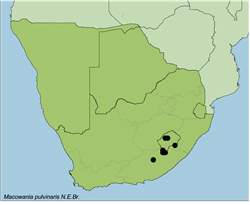Names and synonyms
Macowania pulvinaris N.E. Br.
Type
Galpin 2258, Queenstown div., on the summit of Andriesberg, near Bailey, 2070 m (BOL, K, GRA, NBG).
Common names
'mamotasi'
Derivation of names
Macowania = after Dr. Peter MacOwan (1830-1901), botanist, director of the Cape Town Botanic Gardens, and discoverer of new species at the Cape.
pulvinate = cushion-shaped
Diagnostic characters
Dwarf habit
Leaf tips less attenuated than in M. tenuifolia
Capitula solitary, pedunculate
Peduncles ebracteate
Description
Dwarf, spreading, aromatic, much-branched shrub, forming low, compact cushions. Stems densely leafy when young. Leaves closely imbricated, linear, up to 20 x 1.25 mm, margins strongly revolute, midrib strongly raised below, lower surface white-woolly between margins and midrib, glabrescent, upper surface and midrib below very densely covered in short-stalked glands, tips broadly pointed. Capitula solitary at the branch tips, on peduncles 15-25(-45) mm long, peduncles woolly-hairy and covered in long-stalked glands protruding through the hairs. Involucre funnel-shaped, c. 8-10 x 10 mm. Involucral bracts straw-coloured, lightly woolly, outer surface and margins covered in long-stalked glands. Ray florets yellow, female. Disc florets hermaphrodite, corolla narrowly cylindric below, widening gradually above, with a few hairs immediately below the expanded part. Pappus bristles c. 17, subequal, the longest equalling disc corolla, persistent. Cypselas 2.5 mm long, 10-ribbed, densely covered in stiff hairs.
Flowering time
Mainly from October to January, occasionally to February.
Distribution
Known from the Eastern Cape and Lesotho, mostly between 2000 and 2950 m above sea level.
Known from more than 15 specimens.
Habitat
In ericoid shrub communities throughout the distribution range, mountanous areas.
Notes
M. pulvinaris is very closely allied to M. tenuifolia from which it is distinguished by its dwarf habit, less attenuated leaf tips and ebracteate peduncles. Separately and collectively, the two species have the widest distribution of any in the genus, M. tenuifolia getting as far north as The Downs near Tzaneen in the Limpopo Province.
References
ANDERBERG, A.A. 1991. Taxonomy and phylogeny of the tribe Gnaphalieae (Asteraceae). Opera Botanica 104: 50-53.
BROWN, N.E. 1901. Bulletin of Miscellaneous Information. Kew Bulletin 175-177: 124.
HILLIARD, O.M. & BURTT, B.L. 1976. Notes on some plants of southern Africa chiefly from Natal: V. Notes from the Royal Botanic Garden Edinburgh 34,3: 260-276.
HILLIARD, O.M. 1977. Compositae in Natal. University of Natal Press.
KESTING, D. & CLARKE, H. 2008. Botanical names, what they mean. Wild Flowers of the Cape Peninsula, 3rd revised edition. Friends of Silvermine.
LAWRENCE, G.M. 1989. Taxonomy of Vascular Plants. Macmillan Publishing Co., New York.
POOLEY, E. 2003. Mountain Flowers. A Field guide to the Flora of the Drakensberg and Lesotho. The Flora Publications Trust.
SMITH, C. A. 1927. The genus Macowania, Oliv. Bothalia 2:348-350.
